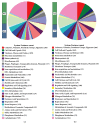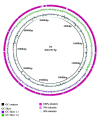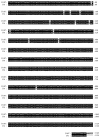Antibiotics Resistance Genes Screening and Comparative Genomics Analysis of Commensal Escherichia coli Isolated from Poultry Farms between China and Sudan
- PMID: 30225258
- PMCID: PMC6129349
- DOI: 10.1155/2018/5327450
Antibiotics Resistance Genes Screening and Comparative Genomics Analysis of Commensal Escherichia coli Isolated from Poultry Farms between China and Sudan
Abstract
Escherichia coli (E. coli) strains, from the gut of animals and humans, harbor wide range of drug resistance genes. A comparative study is conducted on the intestinal E. coli from fecal samples of healthy chicken from China and Sudan in order to monitor the antimicrobial sensitivity pattern. A number of 250 E. coli isolates from chicken farms, including 120 from China and 130 from Sudan, were isolated and identified. All isolates were subjected to susceptibility tests against 10 antibiotics and the distribution of antibiotic resistant genes was confirmed by PCR amplification, involving genes such as ampC, tetA, pKD13, acrA, ermA, ermB, ermC, tetB, mphA, aadA14, aadA1, aac3-1, and aac3- III. Many isolates were found to exhibit resistance against more than one antibiotic. However, the Chinese isolates showed more antibiotics resistance and resistance genes compared to the Sudanese isolates. For better understanding of the multidrug resistance factors, we conducted whole genome analyses of E. coli D107 isolated from China, which revealed that the genome possesses multiple resistance genes including tetracycline, erythromycin, and kanamycin. Furthermore, E. coli D4 isolate from Sudan was more sensitive to antibiotics such as erythromycin, tetracycline, and gentamicin. After analysis by RAST and MAUVE, the two strains showed 89% average nucleotide identity. However, the genomes mostly differed at the number of antibiotics-related genes, as the genome of D107 revealed a considerable number of antibiotics resistance genes such as ermA and mphD which were found to be absent in D4 genome. These outcomes provided confirmation that the poultry farms environment in different countries (China and Sudan) may serve as a potential reservoir of antimicrobial resistance genes and also indicated the evolutionary differences of strains in terms of resistant genes expression.
Figures




References
-
- Bunner C. A., Norby B., Bartlett P. C., Erskine R. J., Downes F. P., Kaneene J. B. Prevalence and pattern of antimicrobial susceptibility in Escherichia coli isolated from pigs reared under antimicrobial-free and conventional production methods. Journal of the American Veterinary Medical Association. 2007;231(2):275–283. doi: 10.2460/javma.231.2.275. - DOI - PubMed
MeSH terms
Substances
LinkOut - more resources
Full Text Sources
Other Literature Sources
Medical

